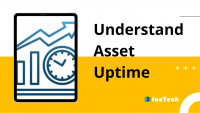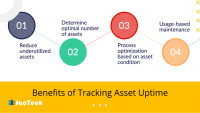Tracking Critical Asset Uptime
If you are in charge of maintaining any kind of facility, you must be aware that the lifeblood of your operations is asset uptime. It is the actual running time of your vital equipment. Your bottom line will be happier and you will be more productive the more of your important assets are in use. With the help of an asset management system, you can track the uptime of the critical assets and improve the productivity.
But how can you prevent those dreaded breakdowns and keep your essential machines in excellent shape? That’s where tracking important asset uptime’s magic resides. Consider it as closely monitoring the condition of your most crucial asset to enable early problem detection and maintenance of seamless operation.
You could be thinking now, “We already do maintenance. Is that not enough? Although regular maintenance is absolutely crucial—we’ll call this being a good doctor for your machines—just following a timetable may not be the most effective approach. Sometimes you’re correcting something that isn’t broken yet and other times an issue finds you between planned inspections.
This is where a more intelligent approach based on data tells you precisely how your assets are performing. And that’s where a contemporary asset management system provided by Factech particularly excels.

Understand Asset Uptime
The length of time a given asset or machinery stays operational and productive, generating its anticipated output without any unplanned downtime, is known as asset uptime. Crucially for continuous operations, it covers the general availability and performance of assets, including machines, tools, buildings, infrastructure, and facilities.
Also, read asset management and maintenance system
Essential Elements of Asset Uptime
Availability:
Availability is the proportion of time an asset is used and ready. It affects scheduled maintenance, repair timeframes, and any unanticipated failures. High availability represents less downtime and the best use of resources.
Reliability:
Reliability is about the consistency and dependability of assets in providing intended results over a certain period. Reliable assets promote operational stability by displaying low failure rates and constantly operating under different situations.
Maintaining Simplicity:
Maintaining assets, including repair times, accessibility of spare parts, and preventative maintenance procedures, depends on maintainability—that is, how easily and quickly one may maintain them. Effective maintenance techniques reduce downtime during operations, thereby improving asset uptime.

Benefits of Tracking Asset Uptime
Less Unscheduled Repair Work
Strategic monitoring of the health and performance of most valuable assets by companies helps them to save operating expenses and lessen the possibility of breakdowns leading to unexpected repairs. Preventive and predictive maintenance strategies help them to increase their forecasting capacity and enable them to arrange repairs when it would be most appropriate.
Lowered Maintenance Expenses
Maintaining the health and productivity of the assets of an organization depends on maintenance chores. Still, their expenses might vary significantly and affect the profitability of the company. Strong performance maintenance approaches produce improvements in decision-making capacity that enable companies to avoid doing pointless and too much maintenance.
Enhancements in Asset Performance
Modern asset management solutions increase asset availability and asset condition by deploying predictive and preventive maintenance using artificial intelligence and machine learning (ML) capabilities. These new technologies enable operators to better suggest maintenance plans that help lower expensive downtime for assets the business depends on.
Increased Operational Effectiveness
Many asset-rich companies nowadays leverage artificial intelligence (AI) and Internet of Things (IoT) technologies as part of a whole asset management approach to assist them in identifying chances for higher efficiency. Business executives used to have to wait until the end of the month or quarter to examine performance figures; today, they can access the same data instantly.

How Would an Asset Tracking System Be Useful?
Using a range of technologies, including barcode scanners, GPS, and RFID, an asset management system presents a strong facility to track assets in real time. Accurate information gathered by asset tagging lets companies keep an eye on the state of their products all through their lifetime.
Companies can track compliance rules together with their assets to apply quality control policies. This guarantees departmental product standardization and helps to reduce significant fines. Furthermore, an asset management system informs important occurrences, including maintenance, procurement, and disposal, to guarantee flawless operational performance always.
Factech: Your Partner in Maximizing Asset Uptime
We know that maintaining vital assets in functioning order is absolutely crucial for companies. Our system gives you the instruments you need to:
- Track your important equipment’s uptime relentlessly.
- Discover important new angles on asset performance.
- Point out possible issues before they generate expensive downtime.
- Real data will help you to maximize your maintenance plans.
- Eventually increase the dependability and effectiveness of your operations.
Using Factech‘s Asset Management System helps you to take control over your assets and create a stronger and more efficient facility, therefore transcending mere numerical tracking.
The bottom line
Beyond reactive repairs and even planned preventative actions, knowing and actively tracking asset uptime with a strong Factech asset management system offers unmatched insights into equipment condition and performance. By allowing companies to predict problems, streamline maintenance plans, save running costs, extend asset lifetime, and finally increase general output, this proactive strategy helps businesses to convert their maintenance plans from a cost center to a strategic advantage by using real-time data and cognitive analytics, therefore ensuring that their key assets remain operational and best support their corporate goals.
FAQs
Q.1 What is asset uptime and why is it important?
The number of times vital equipment runs without unplanned downtime is known as asset uptime. Profitability, production, and ongoing operations depend on it.
Q.2 How may tracking asset uptime help to lower expenses?
Tracking uptime helps prevent expensive unplanned breakdowns, reduces emergency repairs, and maximizes maintenance schedules, therefore avoiding unneeded interventions by means of predictive and proactive maintenance.
Q.3 How does an asset management system such as Factech help to monitor uptime?
Factech’s system offers tools to constantly monitor operational hours, track down incidents of downtime, examine performance statistics, create uptime reports, and create alarms for preventative maintenance.
Q.4 How can Factech maximize asset uptime and hence provide the advantages?
Factech offers insights into asset performance, easily tracks uptime, finds early possible problems, maximizes maintenance, and finally increases the dependability and efficiency of operations.












